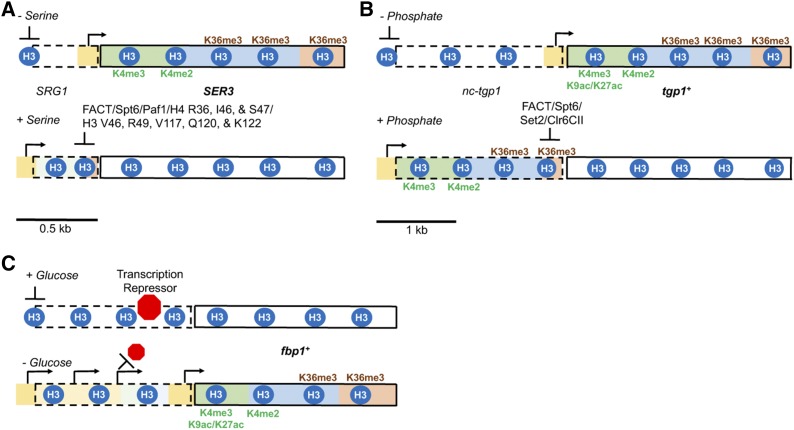Figure 4.
Distinct mechanisms of lncRNA transcription-mediated gene regulation. (A) Serine-starvation induces SER3 expression in S. cerevisiae. In presence of serine, SER3 is repressed by transcription of the SRG1 lncRNA, which is initiated from a promoter positioned roughly 0.5 kb upstream of the SER3 transcription start site (Martens et al. 2004, 2005). Repression in this instance requires cotranscriptional changes in nucleosome positions over the SER3 promoter mediated by histone chaperones FACT and Spt6 (Hainer et al. 2011). Efficient SRG1-mediated SER3 repression also requires the PAF1 complex (Pruneski et al. 2011). SRG1 is too short for transcription elongation to deposit significant levels of H3K4me2 or H3K36me3, which explains why Set1 and Set2 are not required for regulating SER3 expression (Hainer et al. 2011). In contrast, other less characterized histone tail residues are implicated in SER3 repression by SRG1 (e.g., H3V46, H3R49, H3V117, H3Q120, H3K122, H4R36, H4I46, and H4S47) (Hainer and Martens 2011) (B) In S. pombe, the 2 kb cryptic lncRNA nc-tgp1 represses the tgp1+ gene in response to phosphate availability (Ard et al. 2014). FACT and Spt6, along with Set2 and Clr6Rpd3S, all partially contribute to the suppression of tgp1+ by nc-tgp1 transcription (Ard and Allshire 2016). The role of the PAF1 complex in tgp1+ regulation has yet to be explored. Related mechanisms have been reported for lncRNA-mediated repression of the pho1+ gene in S. pombe (Ard and Allshire 2016) and the IME1 gene in S. cerevisiae (van Werven et al. 2012). (C) The S. pombe fbp1+ gene is repressed when cells are grown in the presence of glucose. Unlike the examples described in (A and B), fbp1+ expression following glucose starvation is stimulated by the transcription of multiple upstream lncRNAs (Hirota et al. 2008). While the act of transcription is thought to help displace transcriptional repressors Tup11 and Tup12 (Takemata et al. 2016), it is unclear why cotranscriptional chromatin changes do not repress the fbp1+ promoter. Whether differences in the recruitment of elongation factors to RNAPII during some acts of noncoding transcription (Battaglia et al. 2017; Fischl et al. 2017) help to explain mechanistic differences is worth exploring in future studies. FACT, facilitates chromatin transcription; H3, histone H3; lncRNA, long noncoding RNA; RNAPII, RNA Polymerase II.

